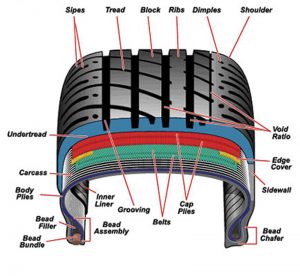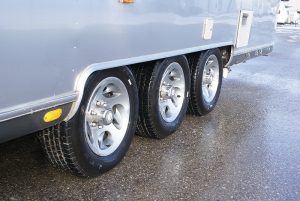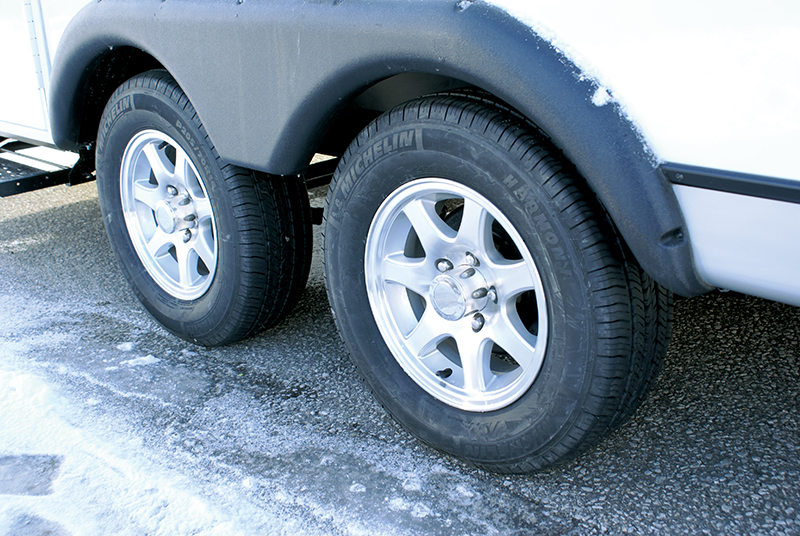205/70R x 14″ tires on a lite trailer.
Proper tire size and type makes all the difference!
by Andy Thompson

I often speak about tow vehicle tires in this column but today I thought I would discuss tires for your trailer or fifth wheel. While I would not often recommend throwing away new tires, when it does come time for replacement there are often much better tires than the original equipment models.
The exception to this would be if your trailer has bias ply tires. It seems ridiculous that many trailers today come equipped with bias ply tires. Radial tires have been used on the majority of cars in North America since 1973, and they are far superior to bias ply tires in terms of ride, handling, traction, and durability, plus – they have less rolling resistance. The bias ply tires that some trailers are equipped with are not very good quality and they should not be used for any amount of travel. If your trailer just goes a few miles to a stationary site each year these bias-ply tires are fine but if you plan to do any more than a few hundred miles of travel each season you should toss them and put on something safer and more durable. I know this might seem like you are throwing away good tires, but these are $20.00 tires so you are not throwing away much. How do you know what kind of tires you have on your trailer? All radial tires have a letter “R” in their size – for example 225 75R x 15”.
One line of trailers that we sell comes from the factory with bias ply tires, so we change all of them to radials before we deliver the trailers. Somehow, during the busy period last spring, one of these trailers snuck through without having the tires changed. The customer took a trip from London to Banff and back and reported that their trailer had somehow come to them with old tires. They were not old at all – they were brand new bias plies that just looked old and worn out after one trip. After apologizing profusely, we installed the new radials.
Even within the radial tire category, there are tires that are a compromise of features and cost. Some of the radial “ST” (Travel Trailer) tires that are installed by RV manufacturers are supplied by “the lowest bidder”. For many RV owners who do not tow substantial miles, these radial “ST” tires represent a reasonably good value and they will succumb to many years of exposure to sunlight before they wear out. However if it is time to replace your original ST tires, or if you do a lot of travelling and you are having tire reliability issues, then an alter-native is a good idea. The alternative is going to be either an “LT” (Light Truck) tire or in some cases a “P” (Passenger) tire. Usually a much better quality light truck or passenger tire is available for about the same price as an ST tire.

The first step to upgrading your tires is to know the weight your trailer tires carry when you are loaded for travel and connected to your tow vehicle. The only way to do this accurately is to weigh your combination. Do not weigh your trailer alone as the axle loading changes when you hook up either with a weight distribution hitch or when you connect a fifth wheel. In previous columns I have written about this in more detail but what you need is a scale that is sectioned off to weigh your different axles or group of axles individually.
Once you know the weight on your trailer axle(s) you can divide by the number of tires and get the individual tire loading. For example, if you have an axle weight on your tandem axle trailer of 7200 pounds then you have an individual tire loading of 1800 pounds. On a trailer such as this you would likely have ST225/75R x 15” load range “D” tires rated to carry 2540 pounds at 65 PSI. A good replacement for this is a 235/75R x 15” LT load range “C” tire rated for 1985 Pounds at 50 PSI. Some of you likely are thinking that I must be nuts to remove a D range 2540 pound tire for a considerably lower rated C range tire. As is often the case, ratings can be what you want them to be. When a trailer tire blows it is very rarely a safety issue if there is no loss of control – in fact, you likely won’t even feel it happen on a tandem axle, and even on a single axle there is not a lot of sensation in the tow vehicle. This means that a trailer tire does not have to be tested to the extremes of a light truck or passenger tire, where the results of a blow out can be considerably more serious. So the “ST” travel trailer tires are speed rated somewhere between 65 & 75 MPH but an LT or Passenger tire will usually be speed rated to at least 100 MPH. Not that you will tow at 100 MPH – but a tire that can carry it’s load at 100 MPH has to be able to dissipate heat better and stand up to much harsher road conditions which gives it more margin at lower speeds.
Another interesting spec is that the LT tire weighs almost the same as the much higher rated ST tire. This is interesting because it implies that it can carry all that extra weight without any more material in the tire. I am pretty sure that if you put one of each of these tires on an axle and keep loading it until it fails, the LT tire would outperform the ST. Please note that I am not suggesting that you over-load any tire – even though it could likely handle more than 1985 pounds that should be the limit of the load carried by that tire. Besides being far less likely to fail, the LT tires have another big advantage; far more traction in a panic stop, especially if it is wet. In fact, a trailer’s 12 x 2” electric brakes have a very hard time locking up the LT tire even in wet road conditions.
What if your trailer has 15” ST tires and the weight of the trailer puts the tire load close to the 2540 pound rating? For example, let’s say that your tandem axles are carrying 9800 pounds or 2450 pounds per tire. If your trailer is in this weight class you are likely having a fair bit of tire trouble with ST tires, but there is not a 15” LT or Passenger tire rated to carry anywhere near 2500 pounds. The option then is to change to 16” rims and 225/75R x 16” LT load range “E” LT tires rated for 2680 pounds. This will mean purchasing new rims, however if you do a lot of travelling the LT tires will likely last you twice as long. You can keep the 15” spare tire as it will be close enough to suffice as a spare on the slim chance that you ever have trouble with the LT tires. The 16” tire is 1” larger in diameter or 1/2” larger in radius, which means that you will need 1/2” more clearance in your wheel wells to install them –this is usually not an issue.
You may be thinking that I have made the case for installing LT tires on your trailer, but why would you ever install “P” Passenger car tires on a trailer? Well, for much the same reasons as we install the LT tires – durability, traction and reliability. Passenger car tires are not tested quite as stringently as an LT tire. For example, a P235/75R x 15” tire is rated to carry 2183 pounds – almost 200 pounds more than the LT. A passenger tire of the same size will ride smoother but it will tend to have more sidewall roll than the LT tire. Where we use passenger tires however we do not generally use the same size. Many “lite” trailers on tandem axles have very little weight per tire – often less than 1,000 pounds per tire. In this case, we would like to lower the overall height and improve the tire quality. Though the standard tire is an ST205/75 x 14” we change to a P205/70R x 14” – this is a performance tire with a firmer sidewall that can carry up to 44 PSI, although for these trailer weights 35 PSI is plenty of pressure. The P-series tire is rated for 1433 pounds of load capacity, well beyond what is required for a light trailer. In the mid ’90s, large trailers and fifth wheels all came with LT tires because there were no 16” trailer tires made at that time. One company did have an issue with treads flying off the LT tires, which seemed to make no sense. The particular tire had been used on trucks for many years without problems, and yet the much less demanding roll of a trailer tire seemed to make them fly apart. As it turned out, this particular tire was constructed so that fabric sidewall plies wrapped over the steel belted tread. In trailer use, where the two tires fight each other during turns, the tread plies sawed through the sidewall plies. I know of no tire manufacturer that uses this method today, but there is no way to know for certain, and the information is not easy to find. As result, I always use quality name brand tires. I would stay away from no-name and discount brands until they have proven themselves over the long haul.
One other caution when doing a wheel rim change is that you should maintain the same wheel offset. Offset is the position of the bolt surface in relation to the centre of the rim. On a front drive car the wheels have a large negative offset, a deep dish wheel is a positive offset. Most trailer wheels are 0 offset. If you have conventional wheel bearings and you are within an inch of the original offset then you will be fine. With the newer permanently lubricated or cartridge type bearings there is no leeway – you have to match the original offset.
Generally, trailer tires are not balanced. In fact, Airstream is the only company I know of that balances their trailer tires. Often the tire installer will skip balancing if they know the tires are for a trailer, so make certain you specify that you want balancing. It extends the life of your trailer suspension components, tires, and the trailer itself.
Some of these changes are pretty straightforward but if you have a trailer tire question that falls into the grey area, or if you are not sure which tire would be best choice, please feel free to send me an email. Please include your trailer weight and other specifications and I will be happy to help you out. By the way if you know someone who needs some real cheap bias-ply trailer tires, I have a bunch.























